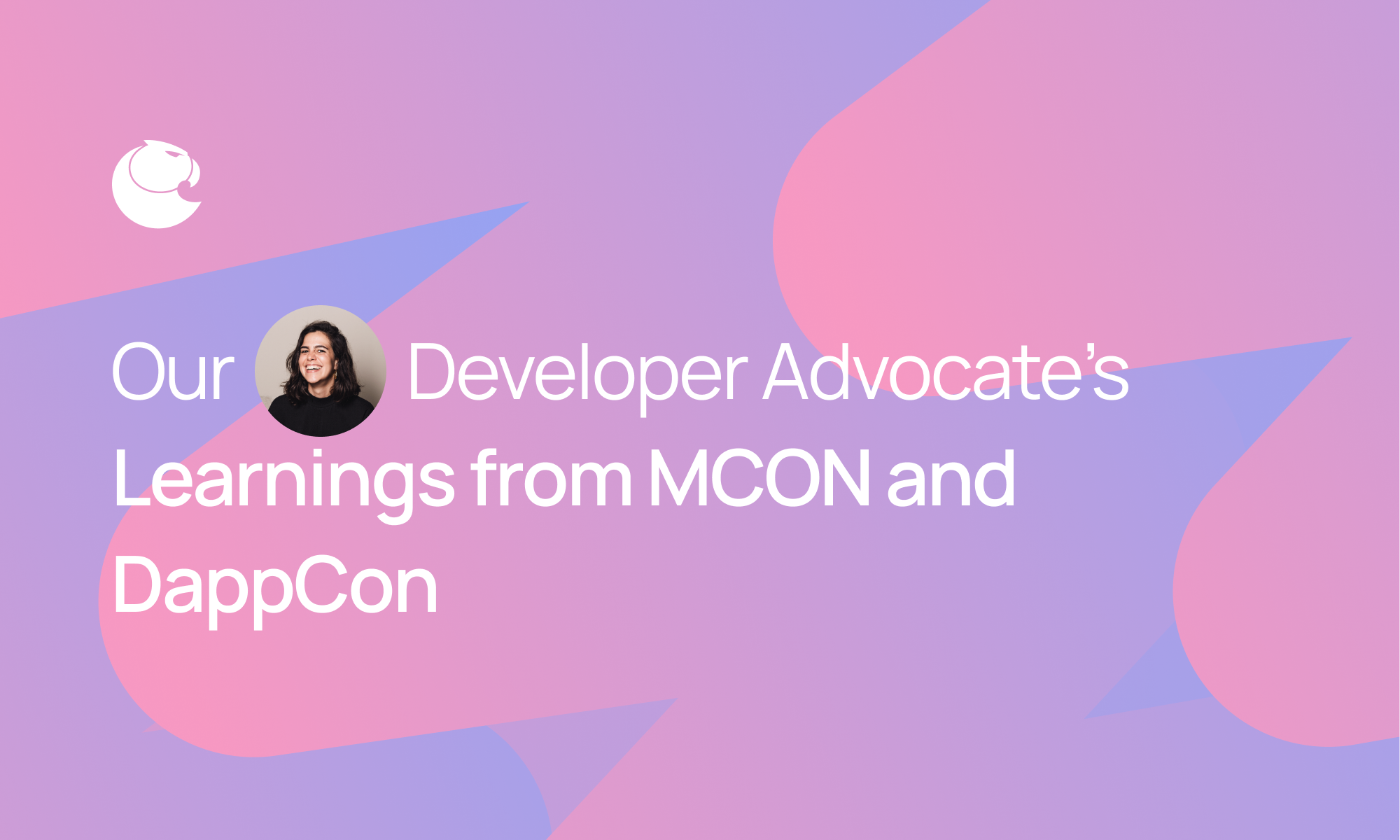Our Developer Advocate Shares Learnings from MCON and DappCon
After attending MCON and DappCon back-to-back, here are some patterns that became prevalent to our Developer Advocate Juliette Chevalier.
Aragon

Conferences are always an interesting glimpse into where the ecosystem is headed.
Through listening to talks, attending side events, and having friendly conversations in-between presentations, we learn about what people are most excited about, what trade-offs we’re all thinking through, and the best practices that are flourishing from experience.

After attending MCON and DappCon back-to-back, here are some patterns that became prevalent to our Developer Advocate Juliette Chevalier:

Product-developer fit leads to product-market fit
Because the protocol layer is open for anyone to read on the blockchain, it inevitably works as a developer-facing product. Teams have to deploy the contracts in order to build the interface, which means that developers are seeing what’s coming first.
Devs are the early adopters of web3 products and the ones truly grasping the potential of what’s possible. So, they’re also the ones driving the product-market fit.
Front-end interfaces then serve as the mechanism through which non-technical users can interact with these contracts. The frontend and the backend are two different products targeting two different audiences.
To reach the audience through the app layer, we need to bring the devs in first.
Product-market fit can only be achieved once the developers decide your product is worth building upon.
The devs truly are the users of the ecosystem, and attracting them should always be your first goal as a new protocol.

Memes are the strongest form of narrative
Memes have proliferated on crypto twitter in the last few years, but they have more use-cases than just fun: they build movements. Memes transmit behavior-changing ideas to a wide-ranging audience.
In Web3, memes shape industry-wide understanding of what we’re building and why it matters.
Nailing down the what and the why of our projects through a simple, easy-to-digest meme is one of the strongest, most sustainable signals a project can send.
Memes don’t have to be funny—they can be narratives, talking points, mental models, or anything that sticks and proliferates. When building the narrative of your organization, think deeply about what is memorable, what is unique, and what might peek users’ interest in the form of a short sentence, idea, or image. Memes truly feel like the future of marketing!

Current compensation models within DAOs hinder us from recruiting skilled, diverse talent
Right now, many DAOs operate with bounties and one-off assignments to contributors. This prevents top talent from sticking in an organization and leads to disjointed contributions that aren’t as high-quality as they could be.
Although project-based models work well for many freelancers, moonlighters, and young professionals building a portfolio, the lack of job security and clear career paths within DAOs does not encourage long-term, diverse talent to join crypto projects.
Not all jobs can be done through a bounty or a short-term contract, and often the most rewarding projects require longer than a few months of commitment. Offering opportunities paid in stablecoins rather than native tokens, creating an opportunity for DAO contributors to get benefits such as health insurance, providing legal protection for contributors, and hiring formally rather than off-the-books can provide opportunities for diverse and under-represented groups to join forces.
As we strive to build the new wave of the internet, building it with a more diverse group is a key aspect of making this a reality.

Engineers drive software and product lifecycles in web3
Web2 and web3 software and product lifecycles have some key differences that make building in this space an entirely new frontier.
In web2, entrepreneurs and UX designers come up with an idea, prototype it, and pass it on to developers to build the front and back-end infrastructure of the product. Web3 is completely different: with just a few thousand developers who can code in Solidity, web3 is much more dev-run than entrepreneuer-run. In other words, the devs are the entrepreneuers.
There are many layers beyond just the number imbalance of web2 devs vs. web3. The blockchain is immutable, so each new smart contract deployment must be well thought-out, planned, and audited, which means no more “move fast and break things” or endless A/B testing. Web3 is also open by default, meaning all code is open-sourced and publicly readable on the blockchain and in Github repos. Thinking of building a moat around your code? Think again.
Security audits are another layer putting devs in the driver’s seat. Engineers have the final say on what stays and what doesn’t, not entrepreneurs or marketers. And every time a new feature is added, the smart contracts need to go through another months-long auditing process and redeployment to the blockchain.
Lastly, the decentralized decision-making ethos contributes to devs driving product development. They like to build a product and let it run, rather than having control over every aspect of it for its entire lifecycle. It’s more common to build something and set it free to the ecosystem rather than to hold on tightly and build a unicorn startup around it.
Due to contract immutability, the open-source inevitability of web3, the need for security audits before launch, and the decentralized ethos of decision-making within the industry, the engineers are mostly the ones who end up establishing a product’s functionality, rather than the UX designers or entrepreneurs of the web2 world.
In short, engineers drive the software development lifecycle in web3.
This is entirely different from our Web2 software engineering practices, where the back-end infrastructure is built based on the front-end demands. In web3, the user interface is built to service the protocol. The back-end is where everything starts, and we need to translate that code into human-readable, easy-to-interact-with apps on top.

Finding a web3 revenue-generating model is extremely hard
Crypto innovation moves incredibly fast because of open-source composability. Developers can fork open-source code and build on top of it, rather than having to start over from scratch every time.
The open-source, forking-friendly environment makes it incredibly hard to find a sustainable business model.
If everyone everywhere in the world can use your code, how do you build a moat around your business?
Open-source software generates an ecosystem of public goods, or software provided for free. The composability we enjoy means we’re able to build on top of each other’s work and advance faster as a collective. It also means finding a proprietary value proposition is almost impossible. Most existing web3 revenue streams have revolved around speculative assets. This method is great for raising initial funding rounds, but hardly function well as sustainable revenue models.
Projects continue to struggle to find ways to accrue value, without the extractive practices that have reigned in web2 to this day. It will be interesting to keep up with the projects thinking this through and see what choices they make around value accrual.

DAOs are tightening up membership and permissioning their onboarding processes
Early DAOs often used a “come one come all” strategy, opening their Discord and Forum to the world and airdropping their native tokens to thousands of people. But, DAOs quickly realized that that strategy incentivized “token go up” attitudes rather than meaningful community building and membership.
After the airdropping hype of the last bull run, organizations are realizing that community members with few incentives to contribute holistically, from a mindset beyond just profits, can be extremely detrimental to an organization. This is especially true for organizations building a product from scratch on a low budget.
In response to these learnings, DAOs today are tightening up and restricting membership, as well as thinking more carefully about who they onboard and why.
Strategies for onboarding and attracting the right mission-aligned community members are key to ensuring a DAO’s mission is fulfilled. Getting mission-aligned contributors in the door helps keep everyone on the same page, moving toward a single goal. Equally as important are offboarding practices, or transitioning someone out of an existing role in the DAO, which encourage a healthy organization and shared responsibility.
SubDAOs and permission management systems are also becoming extremely popular. Autonomous, tightly aligned, but loosely coupled organizations are emerging as a way to solve for scalability, without loosing productivity and accountability.

DAOs are in their teenage and experimentation phase, and we’re here for it
Redesigning how we collaborate at scale is a task of giants. Within DAOs, we’re experimenting with governance at the speed of software, breaking old paradigms of governance, and reconstructing centuries-old structures.
Sometimes our experiments work, other times we find ourselves right where we started. We're going through this acne-filled, self-awareness stage to reach a sustainable path to adulthood.
We’re throwing spaghetti at a wall and seeing what sticks, hoping for a new model that makes the old one obsolete.
If you’re passionate about redesigning collaboration at scale, this is a great time to get involved in DAOs.
Why? Because every decision we’re making will impact the years to come. We’re laying the foundational groundwork for digital organizations to succeed. Having the chance to rethink structures and build from scratch is an incredibly exciting opportunity, and one we shouldn’t squander.
If you’re building a DAO, check out our upcoming Aragon App for onchain deployment and join the early access list to be one of the first to hear about the release. Or, if you’re already in the process and looking for help on your journey, check out our verified and vetted DAO Experts to find the service provider that fits your needs today!
Subscribe to The Eagle for weekly news on the Aragon Network
